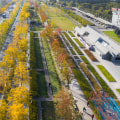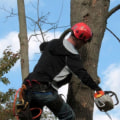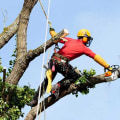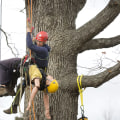The most common job of a professional tree climber is as an arborist or tree doctor. A professional tree climber is a person who ascends and descends trees to perform essential work tasks. Owners of private homes, cities and businesses can employ professional tree climbers for various services. Tree climbers can work alone, with an experienced arboriculture professional, or within a team of tree climbers.
They often work with an aerial lift specialist who helps them climb trees and makes sure their ropes are secure and supportive. For most of us, climbing trees is a phase we grow from when we reach puberty and we can appreciate the risks of a broken bone. But professional tree climbers never grow out of the need to climb the nearest strong oak or elm. In fact, they are paid to do so.
Professional tree climbers often also act as arborists, also known as people who help keep trees healthy. They cut down dead branches and prune trees to make them look attractive and are safe to walk underneath. However, some tree climbers also work as guides in tourism or recreation, as recreational tree climbing is becoming increasingly popular with the young at heart. As you can probably imagine, climbing trees isn't a skill you can specialize in at most universities, which explains why few tree climbers have bachelor's degrees.
Most learn the tools of the trade on the job, such as using climbing ropes and saddles to climb trees. Professional tree climbing is much more technical than struggling to reach the nearest branch in childhood. Depending on where they work, they may also be responsible for climbing trees (often with ropes) and some trees can grow to become very large. Safety when climbing a tree is a must, so those who climb trees are also highly rated in this area.
Arborists are also sometimes called tree surgeons, as they must not only remove dead branches and prune a tree when needed, but they also monitor the health of the trees in their care and recommend treatment. A tree climber, or tree pruner, specializes in climbing tall trees to access branches for extraction. As a tree climber, your duty is to use safety equipment and other tools to remove branches that often pose a threat to property. You work under the supervision of an experienced arboriculture professional who can advise you on the best removal tactics.
You should work with your team to remove dead or damaged branches without causing harm to yourself or the property underneath. Spurs is one of the most common terms for spiked climbing tools used by tree climbers or leg posts. They are also called climbers, hooks, earrings, irons or skewers. Tree climbing spurs are typically attached at the ankle with a synthetic strap and around the calf with a second strap that passes through a pad.
Gaff is the appropriate term for the tip portion of the climbing spur. A set of climbing spurs with a tree climbing harness and a flipline is used. Tim Kovar climbed his first tree in his Nebraska backyard at age four. Now a master climbing instructor, he has climbed more than 5,000 trees worldwide, in sites ranging from South America to Southeast Asia and across the U.S.
UU. Many of these trips were organized by biologists, entomologists and other scientists who hired Kovar to collect data on the treetops or to set up platforms for safe ascents. He has taught nearly 1,000 researchers how to climb trees, helped more than two dozen of them in their field sites, and has been recognized in a textbook on treetops at risk. When he's not helping with scientific studies, Kovar can be found in Oregon City, Ore.
Even though some tree climbers have a college degree, it's possible to become one with just a high school degree or GED. All of these disciplines are related and some arborists have a lot of experience in all areas of treework, but not all arborists have the training or experience to properly practice all disciplines. Arborists generally focus on the health and safety of individual plants and trees, rather than managing forests or harvesting wood (forestry or forestry). The consultant's job is to analyze all aspects of the environment and the tree itself to determine the health of the tree and if it represents a potential risk and, if so, how high the risk is.
Depending on the jurisdiction, there can be a number of legal issues surrounding arborist practices, including boundary issues, public safety issues, heritage trees of community value; and neighbor issues such as ownership, obstruction of views, impacts of roots crossing boundaries, annoying problems, quarantine for diseases or insects, and safety of nearby trees. The job of an arborist representative is to meet with business customers, whether residential or commercial, and listen to their tree care needs, or to provide professional advice and make suggestions and perhaps tree management plans. In an arboriculture program, you can learn about various tree species, care techniques, diseases affecting trees, and pesticides. In recent years, research has shown that wound dressings, such as paint, tar, or other coverings, are unnecessary and can damage trees.
In addition to ensuring the health of a tree, they can also plant trees to promote additional growth. False crotches can be installed on any structurally solid part of the tree, freeing the tree climber from relying on the natural branches or crotches of the tree for use as a suspension point. An arborist's work can involve very large and complex trees, or ecological communities and their abiotic components in the context of the landscape ecosystem. This can help improve the health of a tree and prevent harmful organisms from spreading to surrounding trees.
Factors such as shock load will exert many times the weight of the current load on the tree in question. . .






